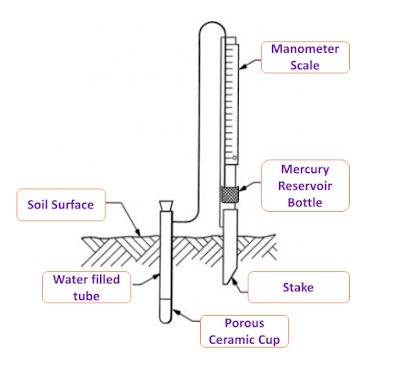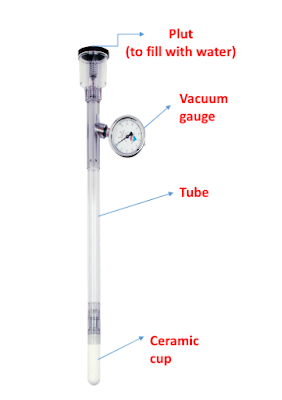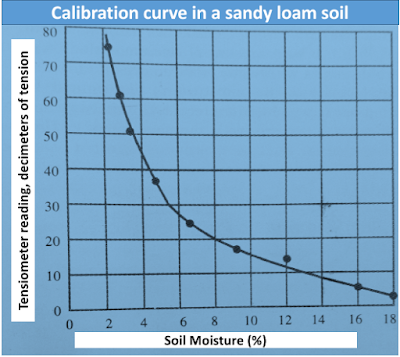TENSIOMETERS
Tensiometers provide a direct measure of the tenacity with which water is held by soils. They measure the metric or capillary potential, they can also be used to estimate the soil moisture content.
The tensiometer consists of a porous ceramic cup filled with water which is buried in the soil at any desired depth and connected to a water filled tube with a manometer or vacuum gauge.
The scales are generally calibrated in either hundredths of an atmosphere or in centimetres of water.
Fig. Tensiometer connected to mercury manometer
Tensiometers that utilize a mercury manometer are preferred as research tools because they afford great precision.
Fig. Tensiometer with vacuum gauge
Because of their simplicity, tensiometers equipped with vacuum gauges are better suited for practical field use.
When the tensiometer is placed in the soil where the tension measurement is to be made, the bulk water inside the porous cup comes into hydraulic contact and tends to equilibrate with soil water through the pores in the ceramic cup.
When initially placed in the soil, water contained in the tensiometer is generally at atmospheric pressure. Soil water, being generally at sub-atmospheric pressure, exercises a suction which draws out a certain amount of water from the rigid and airtight tensiometer, thus causing a drop in its hydrostatic pressure.
This pressure is indicated by the manometer or vacuum gauge. Any increase in tension that occurs as the soil dries causes the gauge or manometer reading to increase, which can be read above ground. Conversely, an increase in soil-water content reduces tension and lowers the reading.
Since the porous cup walls of the tensiometer are permeable to both water and solutes, the water inside the tensiometer assumes the same solute composition and concentration as soil water, and the instrument does not indicate the osmotic suction of soil water (unless equipped with some type of an auxiliary salt sensor).
Tension measurements by tensiometers are generally limited to metric suction values of below 1 atmosphere. This is due to the fact that the vacuum gauge or manometer measures a partial vacuum relative to the external atmospheric pressure, as well as to the general failure of water columns in macroscopic systems to withstand tensions exceeding one atmosphere.
Further, as the ceramic material is generally made of permeable and porous material, too high a suction may cause air entry into the cup, which would equalize the internal pressure to the atmospheric. Under such conditions, soil moisture tension might continue to increase even while the tensiometer fails to show it.
In practice, however, the useful limit of most tensiometers is at about 0.85 atmospheres. The limited range of tension measurable by the tensiometer is not serious since it generally encompasses the greater part of the soil wetness range.
Tensiometer readings reflect soil-moisture tension only; that is, they indicate the relative wetness of the soil surrounding the porous cup. They do not provide direct information on the amount of water held in the soil. Tension measurements are useful in deciding when to irrigate, but they do not indicate how much water should be applied. A special moisture characteristic curve for the particular soil is needed to convert moisture-tension measurements into available moisture percentages.
Tensiometers do not satisfactorily measure the entire range of available moisture in all soil types. But they probably are the best field instruments to use to determine moisture conditions in the wet range.
They are best suited for use in sandy soils since in these soils a large part of the moisture available to plants is held at a tension of less than 1 atmosphere.
Tensiometers are not well suited for use in fine-textured soils in which only a small part of the available moisture is held at tensions of less than 1 atmosphere.



